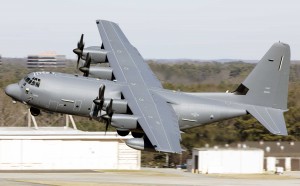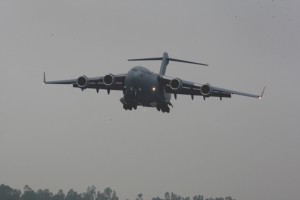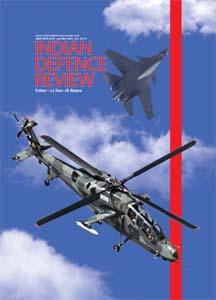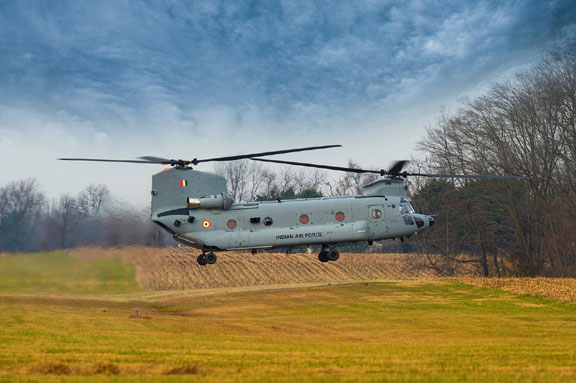
While the US needs India to contain China, India also wants to manage an increasingly assertive China. Rising China and common security concerns have brought the US, Japan, Australia, the ASEAN and India closer in adopting a strategic approach in the region. As the world economies need cheap Chinese goods, so does China need their markets. The bluff has to be called. The world’s biggest democracies finally stand on a shared platform; have some congruence in their world view and most importantly, feel the need to work together on many counts. Aerospace is the real place for joint action. And India and the US have taken a conscious first big step.
Prominent leaders of India’s freedom movement had friendly relations with the United States (US) which continued well after independence in 1947. In 1954, the US made Pakistan an ally to the Central Treaty Organisation (CENTO). To counter the same, India cultivated strategic and military relations with the Soviet Union. In 1961, India became a founding member of the Non-Aligned Movement to remain equidistant in the Cold War power-play between the US and the Soviet Union. The US supported Pakistan during the Indo-Pak war of 1971. In 1991, after the dissolution of the Soviet Union, India adapted to the uni-polar world and developed closer ties with the US. India chose to leverage strategic autonomy to promote national interests.
For over a decade, China has been investing in the Indian Ocean Region (IOR) and using geo-political influence through military supplies, airfield and port construction as also economic aid. India views this as its encirclement.
The US too needed India to counter the rising and somewhat assertive China in its Asia-Pacific pivot strategy. The US demonstrated accommodation to India’s core national interests and acknowledged outstanding concerns. This resulted in increase in bilateral trade and investment, cooperation on global security matters, support for inclusion of India in the United Nations Security Council (UNSC), a greater role in trade and investment fora such as the World Bank, IMF and admission into multi-lateral export control regimes such as the Nuclear Suppliers Group (NSG), the Missile Technology Control Regime (MTCR), the Wassenar Arrangement and the Australia Group. Post 2000, the US became more open to selling high-end military equipment to India. In 2016, India and the US signed the Logistics Exchange Memorandum of Agreement (LEMOA) and India was declared a major defence partner of the US.
On September 06, 2018, India and the US signed the Communications Compatibility and Security Agreement (COMCASA), thus increasing inter-operability between the militaries of the two nations. A 2017 poll by Gallup found that 74 per cent of Americans viewed India favourably. In the year 2017, bilateral trade was $126.1 billion; India’s exports to the US stood at $77.3 billion while US exports to India stood at $48.8 billion. Barrack Obama became the first US President to be the chief guest at the Republic Day parade on January 26, 2015. Aviation is one area which benefitted tremendously due to the increased cooperation between the two nations.
Geo-strategic Appreciation
In spite of the international court ruling against China in the South China Sea (SCS) case on July 12, 2016, belligerent China refused to accept the ruling and claimed to usurp nearly 3.5 million square km of mineral rich sea. SCS has huge oil reserves and is dubbed as the ‘Second Persian Gulf’ and it accounts for nearly 12 per cent of the world’s fishing catch. China has created seven new islets and in turn, extended its Economic Exploitation Zone (EEZ) rights over 90 per cent of the SCS and has enhanced its Air Defence Identification Zone (ADIZ), both of which have serious security and economic implications. China has already constructed ports, military installations and airstrips and thus bolstered its foothold in the region. The route to the SCS is through the Strait of Malacca, the second most used sea-lane in the world with over 30 per cent of world merchant tonnage passing through it.
For over a decade, China has been investing in the Indian Ocean Region (IOR) and using geo-political influence through military supplies, airfield and port construction as also economic aid. India views this as its encirclement. Through its Belt and Road Initiative (BRI) also known as the One Belt One Road (OBOR), China is developing infrastructure and making investments in countries across Europe, Asia and Africa. In the garb of enhancing regional connectivity, China is pushing dominance in global affairs with a China-centered trading network. Investments in the Gwadar port on the mouth of the Persian Gulf in Pakistan and funding of the investment corridor to connect Western China to the sea passing through the disputed Pakistan-occupied-Kashmir, concerns India. China supports Pakistan’s military-industrial-complex in a big way. All these have security implications for India and the US.
The US now views India as a growing world power with common strategic interests and a collaborative future.
US-Russia-China: Multi-Polar Dynamics for India
The Doka La incident on the China-Bhutan-India border has once again indicated China’s rise and unilateral approach to solving border disputes. Russia, the inheritor of Soviet Union’s superpower legacy, now has a well-entrenched powerful muscle-flexing leader in Vladimir Putin. While the US remains well ahead in both Gross Domestic Product (GDP) and military spending, Russia and China are gaining ground and already have significant influence in world affairs. Meanwhile, India is today the fastest growing economy and among the first four countries in most economic and military indicators. India is already the world’s largest democracy and will soon overtake China in population. European economies are slowing down with solar and wind energy becoming cheaper alternatives, oil and the Arab world are losing significance. This implies the trend towards global realignments. Thus, India needs to re-adjust to the emerging global order; China is of immediate concern. Its containment is important. India has signed strategic partnership agreements with more than two dozen countries including France, Russia, Germany, United Kingdom, US, EU, Vietnam, Australia South Korea, Afghanistan, Japan, Singapore and the UAE among others. India’s relations with Israel are also considered ‘strategic’. India is the largest regional investor in Afghanistan.
Indo-US Military relations
US-India military relations seek to advance shared interests in maintaining security and stability, in defeating violent religious extremism and terrorism, in preventing the spread of weapons of mass destruction and associated materials as also in protecting the free flow of commerce. India is key to the ability of the US to create a stable balance of power in the larger Indo-Pacific region and to shore up its credibility in the region in the face of rising Chinese economic and military muscle power. The US now views India as a growing world power with common strategic interests and a collaborative future. In June 2015, Ashton Carter became the first US Secretary of Defence to visit an Indian military command, and similarly in December 2015, Manohar Parrikar became the first Indian Minister of Defence to visit the US Pacific Command. More recently, in September 2018, India and the US held the 2+2 dialogue in New Delhi between the Defence and Foreign Ministers of the two countries.
A large number of GE F404 and F414 engines are being acquired for the LCA Tejas programme making the US among the top three arms suppliers to India.
Initial Aviation Links
The aviation contact between the two nations began after ‘The Hump’ airlift, when Americans airlifted supplies from Eastern India to China starting April 1942, when the Burma Road was blocked by the Japanese during WW II. Several airstrips in East India were constructed during this period. After the War, the US was immediately engaged in the containment of communism. India was considered a high-risk country. The US wanted India to ally with them formally, but India chose to remain non-aligned. Yet the US came to India’s aid after the India-China war of 1962 and assured support in case of repeat aggression. They offered to train the Indian Air Force (IAF) and air exercises between the two countries first began in November 1963. ‘Exercise Shiksha’ was meant to expose the IAF to modern air defence concepts and high performance air combat.
Military Exercises
Indo-US militaries have engaged in several bilateral or multi-lateral exercises during the last decade. The two armies have been conducting Exercise Yudh-Abhyas. The navies of the US, Japan and India participate in the annual ‘Exercise Malabar’, the last one held held in Guam in 2018. The aim was to promote regional security and stability in the Asia-Pacific region as also to increase understanding of each other’s capabilities and learn to work as an integrated team. From 2004 onwards, the Cope India series of Indo-US air exercises began. State-of-the-art aircraft participated from both sides. The IAF got exposed to aerial refueling, AWACS, joint airlifts and para-drop.
Americans engaged in combat with latest Russian technology and Indian combat tactics. The Sukhoi-30MKI, MiG-29, Jaguars, Mirages, MiG-27 and MiG-21 Bison from the IAF participated. Joint humanitarian assistance and disaster relief operations were practiced apart from social interaction. The mutual respect and bonhomie between members cemented a firm foundation for higher bilateralism. The USAF found it a ‘positive experience’ that led to the re-evaluation of some assumptions about US air tactics. Red Flag advanced air combat training exercises at Nellis Air Force Base, Nevada and at Eielson Airbase in Alaska, gave the IAF exposure to a NATO-like air environment. The IAF’s stellar performance in the exercises also stunned some in the US Congress and the Pentagon used the event to renew the call for modernising the US fighter force with stealthy F/A-22s and F-35 Joint Strike Fighters.
US Fixed Wing Aircraft Start Inducting
The air exercises were a prelude to the unfolding of the dream Indo-US aviation story. The IAF purchased six Lockheed C-130J-30 Super Hercules aircraft in early 2008 at a cost of over $1.2 billion for its Special Operations forces under the US government’s Foreign Military Sales (FMS) programme. The first six aircraft were delivered by December 2011 and six more were acquired later. The aircraft can carry loads up to 17,000 kg with a choice between three armored personnel carriers, five pallets, 74 stretchers, 92 equipped combat troops or 64 paratroopers. It has a very modern self-protection suite for penetration behind enemy lines. It has a missile warning system using electro-optic sensors and the BAE Systems AN/ALR-56M radar warning receiver. The aircraft can carry external under wing fuel tanks for longer operating range.
The Boeing CH-47 D/F Chinook twin rotor, heavy-lift helicopters will replace the Russian Mi-26. The 15-helicopter deal is worth about a billion dollars.
The IAF has landed the aircraft at Daulat Beg Oldie (DBO) a short landing ground at an altitude of 17,000 feet in Northern Ladakh close to the Chinese border and Karakoram highway. The aircraft played a very important role in disaster relief operations in Sikkim, Uttarakhand and Kashmir. Ten Boeing C-17 Globemaster III strategic airlift military transport aircraft were inducted next. The C-17s can carry 77.5 tonne vis-à-vis the IL-76 which carries up to 50 tonne. In 2012, India decided to order six additional C-17 aircraft for deliveries past 2017, but this option was not available as the C-17 production line closed down in 2015. Only one C-17 is available which is under acquisition.
The Boeing P-8I Poseidon is a modified Boeing 737-800 designed for Anti-Submarine Warfare (ASW) and ship interdiction roles as also for Electronic Intelligence (ELINT). It carries torpedoes, depth charges, anti-shipping missiles and sono-buoys among other weapons. An agreement was signed in January 2009 for eight P-8Is at a total cost of $2.1 billion. These aircraft are replacing the Indian Navy’s ageing Tupelov Tu-142M maritime surveillance turboprop aircraft. In October 2010, the purchase of four additional P-8Is was approved. The first aircraft was inducted on May 15, 2013, at INS Rajali in Tamil Nadu. In 2009, the IAF’s Communications Squadron inducted three specially-equipped, 46-seater Boeing 737-7HI Business Jets (BBJ) for VVIP duties. Two brand new B-777s have also been procured to replace the older Air India B-747 jumbo jets for VVIP duties. It has still to be decided if these will be operated by Air India or the IAF.
American Rotary Wing Aircraft
22 Boeing Apache Longbow AH-64E will replace the IAF’s older Russian Mi-25/35s attack helicopters. The $1.4-billion deal was also through the FMS route. The IAF will receive the initial batch by 2019. In April 2013, the Indian government decided that henceforth the Indian Army will also have its own fleet of Attack Helicopters. Six additional Apache helicopters are planned for the Indian Army. The aircraft features a nose-mounted sensor suite for target acquisition and night vision systems. It is armed with a 30-mm gun and has four hard points mounted on stub-wing pylons, typically carrying a mixture of AGM-114 Hellfire missiles and Hydra 70 rocket pods. Longbows also have a station on each wingtip for an AIM-92 ATAS twin-missile pack. AH-64s have served in conflicts in the Kosovo, Afghanistan, Lebanon and Iraq.
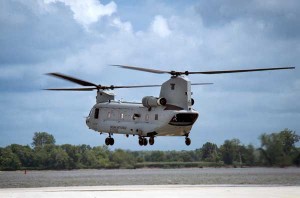 The Boeing CH-47 D/F Chinook twin rotor, heavy-lift helicopters will replace the Russian Mi-26. The 15-helicopter deal is worth about a billion dollars. The CH-47’s primary roles include troop movements, assault missions, artillery emplacement and battlefield re-supply. It has a wide loading ramp at the rear of the fuselage and three external-cargo hooks. The aircraft has considerable combat exposure, having operated in Vietnam, Afghanistan and Iraq. The Chinook is being used in air assault missions and inserting troops into operational areas. With the capability to carry up to 55 troops or 12,700 kg cargo, it is the aircraft of choice for casualty evacuation.
The Boeing CH-47 D/F Chinook twin rotor, heavy-lift helicopters will replace the Russian Mi-26. The 15-helicopter deal is worth about a billion dollars. The CH-47’s primary roles include troop movements, assault missions, artillery emplacement and battlefield re-supply. It has a wide loading ramp at the rear of the fuselage and three external-cargo hooks. The aircraft has considerable combat exposure, having operated in Vietnam, Afghanistan and Iraq. The Chinook is being used in air assault missions and inserting troops into operational areas. With the capability to carry up to 55 troops or 12,700 kg cargo, it is the aircraft of choice for casualty evacuation.
Aircraft Production and Transfer of Technology
The Indian Armed Forces have largely been Russian-equipment centric. These deals with the US mark a major shift toward diversifying defence purchases and moving away from its decades-long near total reliance on Russia. After the foreclosure of the Rafale deal with just 36 direct supply aircraft contract, the IAF needs more Medium Multi-role Combat Aircraft (MMRCA) through the ‘Make in India’ route. The process for acquiring 114 aircraft has begun. Lockheed Martin’s F-16 Block 70 and Boeing’s F-18 Super Hornet are in the fray, offering to transfer significant levels of technology and set up production facilities in India.
Meanwhile, the Indian Navy is in serious discussions with the US Government for technological support for its second Indigenous Aircraft Carrier (IAC II) due out by 2029. The Indian Navy wants to acquire 57 carrier-based aircraft for which F/A-18 Super Hornet is a contender. A large number of GE F404 and F414 engines are being acquired for the LCA Tejas programme making the US among the top three arms suppliers to India.




